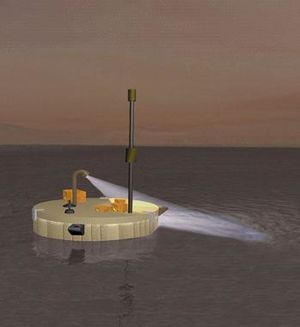Kraken Mare facts for kids

False-color mosaic of synthetic aperture radar images showing all of Kraken Mare. The large island Mayda Insula is left of top center, and Jingpo Lacus is at upper left. A portion of Ligeia Mare enters the view at top right.
|
|
| Feature type | Mare |
|---|---|
| Coordinates | 68°N 310°W / 68°N 310°W |
| Diameter | 1,170 km |
| Eponym | Kraken |
Kraken Mare is the largest known body of liquid on the surface of Saturn's moon Titan. It was discovered by the space probe Cassini in 2007 and was named in 2008 after the Kraken, a legendary sea monster.
Description
At 400,000 km², Kraken Mare is thought to be the largest body of liquid in Titan's north polar region. The maximum depth appears to be 160 meters. Its status as a sea of hydrocarbons (mainly liquid methane) was identified by radar imagery. Kraken Mare is thought to be larger than the Caspian Sea on Earth.
An island in the sea is named Mayda Insula. Kraken Mare may be connected to the second-largest sea on Titan, Ligeia Mare.
The narrow constriction in the sea similar in size to the Strait of Gibraltar, officially named Seldon Fretum, has been termed the 'Throat of Kraken' and suggested to be a location of significant currents. Titan's orbital eccentricity may lead to tides of 1 m in Kraken Mare, generating currents here of 0.5 m/s and possibly whirlpools.
As part of the proposed Titan Saturn System Mission, a probe would splash down on Kraken Mare in order to scrutinize its composition, depth and numerous other properties.
See also
 In Spanish: Mar del Kraken para niños
In Spanish: Mar del Kraken para niños


